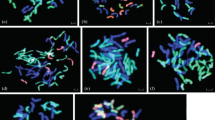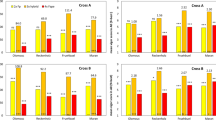Abstract
-
1.
Chromosome numbers, male and female fertility and morphological characters were studied on about 90 plants from each of two natural populations of hybrids between Lolium perenne and Festuca pratensis.
-
2.
In addition to diploid hybrids two triploid hybrid types could be distinguished, a festucoid and a loloid type.
-
3.
Plants of both triploid groups were compared to two classes of experimentally produced triploids, characterized by one Lolium and two Festuca genomes (F2L) and by one Festuca and two Lolium genomes (FL2) respectively.
-
4.
The festucoid groups were in all respects similar to the experimental F2L-plants whereas the loloid groups closely resembled the FL2-plants. It is concluded that the former groups represent the triploid backcross progeny of the diploid F1-hybrid to F. pratensis and that the loloid groups correspond to the triploid backcross progeny to L. perenne.
-
5.
The relative frequencies of the three natural hybrid types diverge considerably in different habitats. Intensity of grazing and moisture conditions seem to be the controlling factors.
-
6.
Observations in the nursery indicate that plants of the constitution FL2 are agronomically most interesting.
-
7.
Alloploids of the constitution F2L2, F4L2 and F2L4 have been produced. Some methods for the production of these alloploids are discussed.
Samenvatting
-
1.
Van grasland in Wageningen (in de uiterwaarden) en in Warmond (langs de Kaagse Plassen) werden populaties verzameld van natuurlijke bastaarden tussen Engels raaigras en beemdlangbloem. Het materiaal werd uitgeplant op een proefveld in Wageningen.
-
2.
Van beide populaties was meer dan 90 procent der planten triplo\:id of ongeveer triplo\:id (3n\s+1 tot 3n\s+4). De rest was diploid. Onder de triplo\:iden vielen duidelijk twee planttypen te onderscheiden die respectievelijk min of meer in stonden tussen de diplo\:ide bastaard en beemdlangbloem en tussen de diplo\:id en Engels raaigras.
-
3.
Planten van beide typen werden vergeleken met twee groepen kunstmatige triplo\:ide bastaarden, nl. een groep F1-bastaarden van diplo\:id Engels raaigras en tetraplo\:id beemdlangbloem en een groep ontstaan door terugkruising van triplo\:ide of amphidiplo\:ide hybriden met diplo\:id raaigras. De eerste groep planten bezat \'e\'en genoom van Lolium en twee Festuca-genomen (genoomformule F2L), de tweede groep had \'e\'en Festuca-genoom en twee Lolium-genomen (genoomformule FL2).
-
4.
De Festuca-achtige triplo\:iden kwamen in allerlei opzichten sterk overeen met F2L-planten; de Lolium-achtige triplo\:iden geleken in hoge mate op de planten met de FL2-constitutie. Aangenomen wordt, dat althans een deel van de planten van de eerste groep ontstaan is door terugkruising van de diplo\:ide bastaard met beemdlangbloem, die van de tweede groep door terugkruising met raaigras. Ze behoeven echter niet alle te behoren tot de eerste terugkruisingsgeneratie. FL2-planten zijn nl. ook geproduceerd door F2L-genotypen te kruisen met diplo\:id raaigras.
-
5.
In de uiterwaarden domineerden triplo\:iden van het F2L-type, bij de Kaag overheersten de FL2-triplo\:iden. Wellicht wordt de frequentie van de verschillende typen vooral bepaald door de beweidingsintensiteit.
-
6.
Op het proefveld maakten de planten van het FL2-type de gunstigste indruk. Dit gold zowel voor natuurlijke als voor kunstmatige triplo\:iden.
-
6.
Door kunstmatige kruising zijn allopolyplo\:iden verkregen van de constitutie F2L2, F4L2 en F2L4. Besproken wordt hoe dergelijke planten ten behoeve van de veredeling op voldoende grote schaal zijn te produceren.
Similar content being viewed by others

References
Carnahan, H. L. and Hill Helen, D., Lolium perenne L × tetraploid Festuca elatior L. triploid hybrids and colchicine treatments for inducing autoallohexaploids. Agron. Journ. 47 (1955): 258–262.
Carnahan, H. L., Cytology and genetics of forage grasses. Bot. Rev. 27 (1961): 1–162.
Essad, S., Analyse cytogénétique de deux amphidiploides Lolium perenne L. × Festuca pratensis Huds. Acad. des Sc. Compt. Rend. 243 (1956): 670–672.
Essad, S., Etude génétique et cytogénétique des espèces Lolium perenne L., Festuca pratensis Huds. et leurs hybrides. Thèses Univ. de Paris, Série A., Orsay no. 8 (1962): 1–116.
Hertzsch, W., Gattungskreuzungen zwischen den Gattungen Festuca und Lolium. A. Kreuzungen zwischen künstlich hergestellten autotetraploiden Festuca pratensis und autotetraploiden Lolium multiflorum. Der Züchter 29 (1959): 203–206.
Hertzsch, W., Kreuzungen innerhalb der Gattung Festuca und zwischen den Gattungen Festuca und Lolium: B. Z.f. Pflanzenz. 44 (1960): 301–318.
Hertzsch, W., Gattungskreuzungen zwischen den Gattungen Festuca und Lolium. C. Die F1-Bastarde, ihr Verhalten und ihr Aussehen. Z.f. Pflanzenz. 45 (1961): 345–360.
Hill Helen, D. and Carnahan, H. L., Lolium perenne L. × induced tetraploid Festuca elatior L. and hybrids with Festuca arundinacea Schreb. Crop Sci. 2 (1962): 245–248.
Jenkin, T. J., Interspecific and intergeneric hybrids in herbage grasses. Initial crosses. J. Genet. 28 (1934): 205–264.
Jenkin, T. J., Interspecific and intergeneric hybrids in herbage grasses. XVII. Further crosses involving Lolium perenne. J. Genet. 53 (1955): 442–466.
Whittington, W. J. and Hill, J., Growth studies on natural hybrids between Lolium perenne and Festuca pratensis. J. Exp. Bot. 12 (1961): 330–340.
Wit, F., Hybrids of ryegrass and meadow fescue and their value for grass breeding. Euphytica 8 (1959): 1–12.
Author information
Authors and Affiliations
Rights and permissions
About this article
Cite this article
Wit, F. Natural and experimental hybrids of ryegrasses and meadow fescue. Euphytica 13, 294–304 (1964). https://doi.org/10.1007/BF00023110
Received:
Issue Date:
DOI: https://doi.org/10.1007/BF00023110



